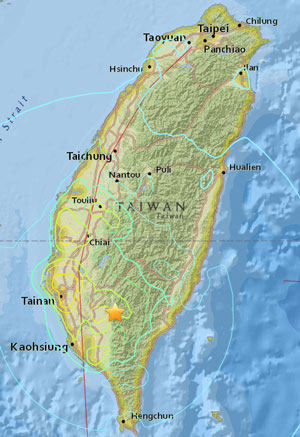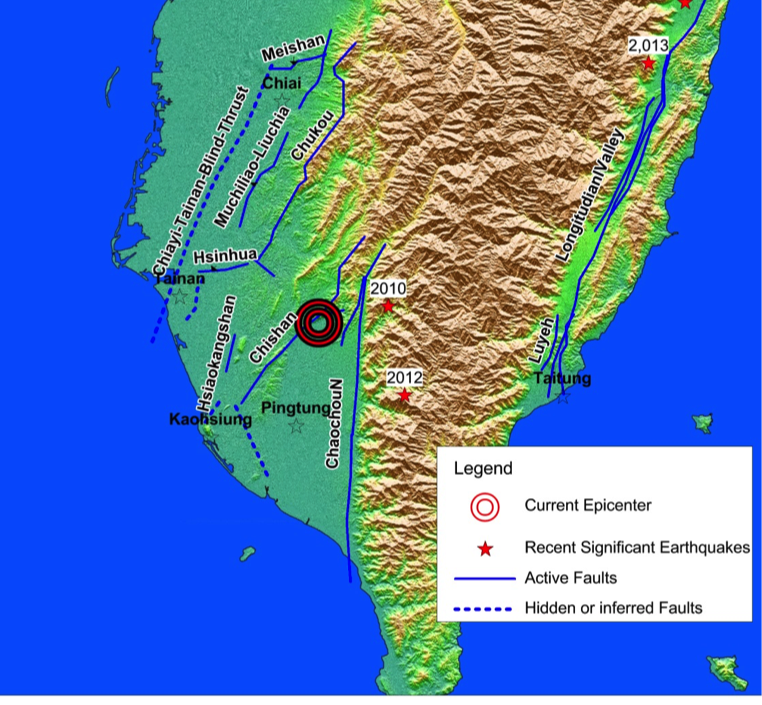M6.4 Taiwan Earthquake
Status: Closed
| Type of posting | Posting date(EST): | Summary | Downloads |
|---|---|---|---|
| First Posting | 2/6/2016 12:00:00 PM |
|
First Posting | Summary
Posting Date: February 6, 2016, 12:00:00 PM
According to the USGS, a magnitude 6.4 earthquake struck southern Taiwan at 19:57 UTC (3:57 on Saturday, February 6, local time) on Friday, February 5, 2016. The epicenter is estimated to be 48 km east southeast of Tainan City and 46 km northeast of Kaohsiung. Focal depth is estimated at 23.0 km (14.3 mi), making this a shallow event. The quake was felt in Taipei, at the northern end of the island, but no damage has been reported in the capital.
The death toll from the quake currently stands at 14, but is expected to rise. More than 100 people are reported missing. The quake collapsed a 17-story residential block in Tainan City. The structure was home to 256 people, but the number of people in the building at the time of collapse may have been much larger as families congregate for the New Year holiday. It was reported that 247 people were pulled from the rubble, but some are believed still trapped under the rubble. Other tall buildings have been left leaning at sometimes extreme angles, suggesting liquefaction. Hundreds of people have been injured by the quake, although most have since been released from hospital.
As of the latest reports, nine buildings collapsed and five were left leaning in Tainan. However, damage does not appear to be widespread. The localized areas and nature of damage indicate that site conditions, building configuration, and shaking directivity may be at play. Building codes in Taiwan are quite strict; however, the common practice of widening the openings of the lower stories to accommodate shopping areas does compromise seismic strength, as has been observed in the past. There is already speculation that the collapsed residential block may not have conformed to codes or that the construction was defective; investigations will undoubtedly follow.
Power was cut to an estimated 120,000 households and transportation links across the country have been disrupted on what is the busiest travel time in Taiwan ahead of the Chinese New Year holiday.
 |
Epicenter of the M6.4 earthquake that struck southern Taiwan on February 5, 2015 (UTC). (Source: USGS) |
Seismology
This earthquake occurred along the Chishan fault line, one of the mapped active faults in southern Taiwan. This is the third earthquake of significant magnitude (~M 6 or larger, as indicated by the red stars in the figure below) in the last 5 years in southern Taiwan. The region, generally, has been relatively quiet in the last 100 years.
The island of Taiwan is located in the collision zone between the Philippine Sea plate and the Eurasia plate where the two plates converge at a rate of 7- 8 cm/year. The collision tectonics has resulted in the rapid rise of the Central Mountain Range across the island, a suture zone fault along the Longitudinal Valley (LVF), and a fold-thrust belt along the western foothills of the Central Mountain Range (FTB). Located within 50 km of major Taiwanese cities, the FTB has been the main source of significant historical earthquakes, including the 1999 Chi-chi earthquake of magnitude 7.6 which devastated central Taiwan and killed more than 2400 people, and the 1935 Hsinchu-Taichung earthquake, the most devastating earthquake in Taiwan’s history.
 |
Crustal faults in southern Taiwan, including the Chishan fault, which may have been the causative fault of yesterday’s event. (Source: AIR) |
Taiwan has been hit by many shallow crustal earthquakes in history. In the last 150 years, most well recorded shallow crustal earthquakes have occurred in the central part of the FTB north of Chiayi and along the LFV in eastern Taiwan. Very few events have occurred in the southern part of FTB. However, recent dense GPS observations have shown that the southern segment of FTB may be more active than the central segment, accommodating as much as 3-4 cm/year convergence across the collision zone. Much of the deformation could be accommodated between Pingtung and Tainan (figure above), along the Chishan fault, which may be responsible for yesterday’s earthquake, and some blind thrust faults between Tainan and Kaohsiung, two of the largest cities in Taiwan. Given the high crustal deformation rates in the region, the blind thrust faults under thick young sediments, such as the Chiayi-Tainan blind thrust fault, are quite capable of generating large earthquakes similar to the 1994 Northridge earthquake in California, or even larger. The Impact of such earthquakes could be much more severe than the impact of this earthquake as they would be located closer to the two cities.
In the 18th century, several earthquakes of about magnitude 7 were reported to have occurred between Tainan and Kaohsiung, but detailed information about the impact of those events is scarce.
Building Code and Enforcement
Multi-story concrete, steel, and masonry are the dominant construction types in Taiwan, particularly in urban areas. A common practice in Taiwan is to widen openings at the ground floor level for commercial use. The practice can result in “soft-story” in structural engineering parlance, which generally comprises a building’s seismic performance if not carefully compensated for.
Prior to 1974, there was no enforced seismic provision. Since then, several major building seismic design codes had been enacted—in 1974, 1982, 1997, 1999, 2005, and most recently in 2011. The first two codes were poorly enforced, and the provisions were started to be well followed only after 1997.
Prior to the 1999 Chi-Chi quake, building codes were designed to withstand shaking from deeper, offshore events. Caused by reverse motion along the Chelungpu crustal fault, the Chi-Chi event had a shallow focal depth and exerted forces that exceeded maximum design specifications being enforced at the time of the quake. At the time, many residential buildings were built with tall, open first floors, designed for storefronts and public use, as noted above. Many of the buildings that collapsed were made unstable due to the “soft-story” effect that results when designs of load-bearing walls differ between the first and upper stories of a building.
After the 1999 Chi-Chi earthquake collapsed more than two dozen apartment buildings and killed more than 2,400 people in central Taiwan, building codes underwent a detailed overhaul and the new provisions were released in December 1999. Performance-based engineering was included in the codes in 2005. Since then, the code provision in Taiwan has been strictly enforced.
It is still in the very early aftermath of this earthquake. The AIR earthquake team is monitoring reports and analyzing observation data. AIR will issue additional information as warranted by events.